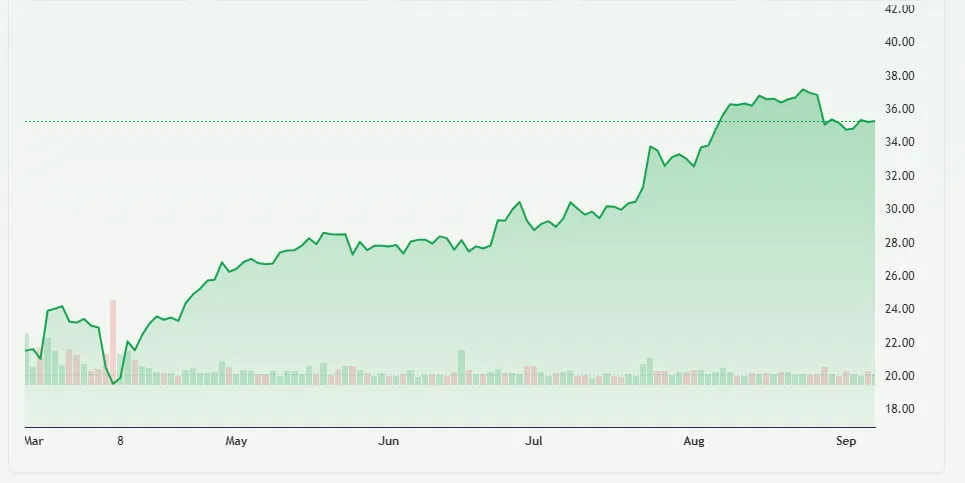Bank of England Expected to Hold Interest Rates as Retail Sales Rise
The Bank of England faces a complex decision as retail sales show strong growth. Recent data reveals retail sales jumped 3.1% in August compared to last year. This increase comes after the central bank’s previous rate cut helped boost consumer spending.
The Bank of England will meet on September 18 to decide on interest rates. Economists now expect the bank to hold rates steady despite positive retail numbers. Deutsche Bank shifted its prediction for the next rate cut from November to December.
Current Retail Sales Performance
August retail sales exceeded expectations across multiple sectors. The 3.1% year-on-year growth marks a significant improvement from previous months. Good weather and the earlier interest rate cut drove this increase.
Food sales led the charge with 4.7% growth year-on-year. Price increases above 4% contributed to this rise. Non-food sales grew more modestly at 1.8% during the same period.
The retail sector averaged 2% growth over the past 12 months. August’s performance represents a strong uptick from last year’s 1% growth. Retailers describe this as a “solid summer” for sales.
Bank of England Rate Decision Factors
Economic Data Analysis
The Bank of England will review four key reports before deciding. These include GDP, labor market, and inflation data. Each report provides crucial insights into economic health.
Current inflation trends show food prices rising 4.9% in July. Staple goods drove most of this increase. The bank must weigh this against retail sales growth.
Labor market conditions remain stable but uncertain. Employment figures will influence the bank’s rate decision. Strong retail sales suggest consumer demand remains healthy.
Deutsche Bank’s Updated Forecast
Deutsche Bank changed its rate cut prediction from November to December. The bank cites increased communication from the Bank of England. The autumn budget scheduled for November 26 also influences this timing.
This shift reflects growing caution about economic conditions. Multiple factors could affect the bank’s decision timeline. The Bank of England appears to favor a wait-and-see approach.

Consumer Confidence Challenges
Consumer confidence fell for three straight months to minus one. This decline contrasts sharply with strong retail sales figures. Shoppers remain worried about future economic conditions.
Food price inflation concerns drive much of this pessimism. Rising costs for essential items affect household budgets. Consumers spend more but feel less confident about their financial future.
The disconnect between sales and confidence creates uncertainty. Strong spending may not continue if sentiment worsens. The Bank of England must consider this psychological factor.
Golden Quarter Concerns
Retailers approach the important “golden quarter” with caution. This period includes back-to-school and holiday shopping seasons. Traditional strong sales periods may face headwinds this year.
Potential tax hikes worry both retailers and consumers. The late November budget timing creates additional uncertainty. Businesses cannot plan effectively without knowing policy changes.
Consumer spending patterns may shift if economic fears grow. The Bank of England recognizes these risks in its planning. Rate decisions must account for future spending trends.
Market Implications and Outlook
The Bank of England’s cautious approach reflects economic complexity. Strong retail sales provide one positive signal. However, declining confidence and inflation concerns create opposing pressures.
Financial markets expect rate stability through the autumn. This stance allows time to assess budget impacts. The December timeline gives policymakers more data to evaluate.
Currency and bond markets respond to Bank of England communications. Clear messaging about rate intentions helps market stability. Uncertainty could create additional economic volatility.
Regional Economic Impact
Different regions show varying retail performance levels. Urban areas generally outperform rural locations. The Bank of England considers these regional differences in policy making.
Employment patterns affect local spending power. Areas with stable job markets show stronger retail growth. Economic policy must address these geographic variations.
Final Thoughts
The Bank of England faces challenging decisions as economic signals point in different directions. Strong retail sales suggest consumer resilience and economic recovery potential. However, declining confidence and persistent inflation create caution.
The September 18 meeting will likely maintain current rates while policymakers gather more data. The Bank of England’s measured approach reflects the complexity of current economic conditions. Future rate decisions will depend on how retail momentum and consumer sentiment evolve through the crucial autumn period.
Disclaimer:
This is for information only, not financial advice. Always do your research.






